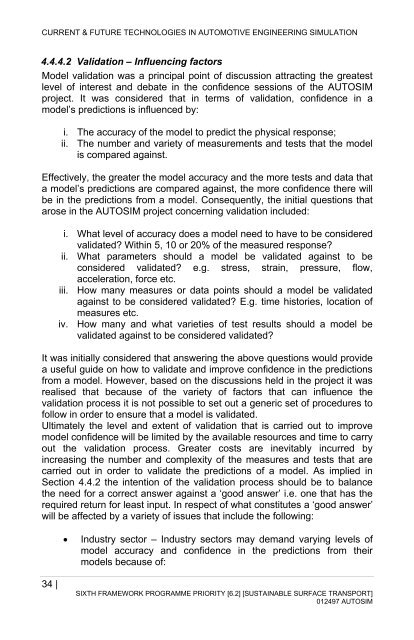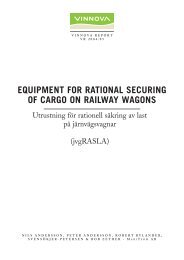Download - Autosim Autosim
Download - Autosim Autosim
Download - Autosim Autosim
Create successful ePaper yourself
Turn your PDF publications into a flip-book with our unique Google optimized e-Paper software.
CURRENT & FUTURE TECHNOLOGIES IN AUTOMOTIVE ENGINEERING SIMULATION<br />
4.4.4.2 Validation – Influencing factors<br />
Model validation was a principal point of discussion attracting the greatest<br />
level of interest and debate in the confidence sessions of the AUTOSIM<br />
project. It was considered that in terms of validation, confidence in a<br />
model’s predictions is influenced by:<br />
i. The accuracy of the model to predict the physical response;<br />
ii. The number and variety of measurements and tests that the model<br />
is compared against.<br />
Effectively, the greater the model accuracy and the more tests and data that<br />
a model’s predictions are compared against, the more confidence there will<br />
be in the predictions from a model. Consequently, the initial questions that<br />
arose in the AUTOSIM project concerning validation included:<br />
i. What level of accuracy does a model need to have to be considered<br />
validated? Within 5, 10 or 20% of the measured response?<br />
ii. What parameters should a model be validated against to be<br />
considered validated? e.g. stress, strain, pressure, flow,<br />
acceleration, force etc.<br />
iii. How many measures or data points should a model be validated<br />
against to be considered validated? E.g. time histories, location of<br />
measures etc.<br />
iv. How many and what varieties of test results should a model be<br />
validated against to be considered validated?<br />
It was initially considered that answering the above questions would provide<br />
a useful guide on how to validate and improve confidence in the predictions<br />
from a model. However, based on the discussions held in the project it was<br />
realised that because of the variety of factors that can influence the<br />
validation process it is not possible to set out a generic set of procedures to<br />
follow in order to ensure that a model is validated.<br />
Ultimately the level and extent of validation that is carried out to improve<br />
model confidence will be limited by the available resources and time to carry<br />
out the validation process. Greater costs are inevitably incurred by<br />
increasing the number and complexity of the measures and tests that are<br />
carried out in order to validate the predictions of a model. As implied in<br />
Section 4.4.2 the intention of the validation process should be to balance<br />
the need for a correct answer against a ‘good answer’ i.e. one that has the<br />
required return for least input. In respect of what constitutes a ‘good answer’<br />
will be affected by a variety of issues that include the following:<br />
• Industry sector – Industry sectors may demand varying levels of<br />
model accuracy and confidence in the predictions from their<br />
models because of:<br />
34 |<br />
SIXTH FRAMEWORK PROGRAMME PRIORITY [6.2] [SUSTAINABLE SURFACE TRANSPORT]<br />
012497 AUTOSIM
















